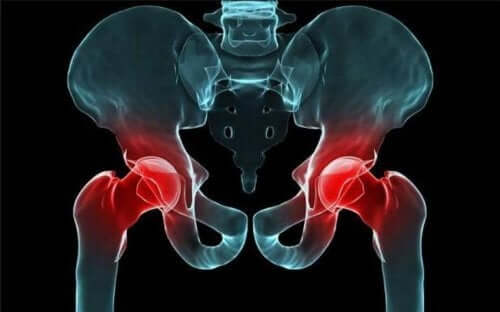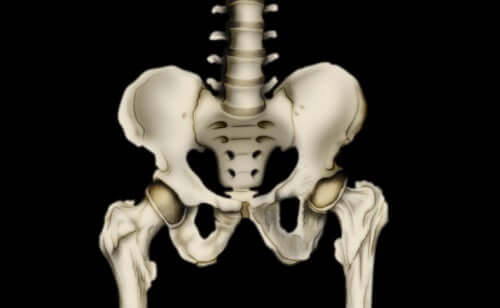Congenital Hip Dislocation in Babies

Congenital hip dislocation is a condition in which the hip joint is abnormal. It’s also known as developmental hip dysplasia. Some babies are born with this malformation, which involves the head of the femur not fitting properly into the joint. This can lead to limping and pain later on.
In the most severe cases, this condition can also be disabling for the person who has it.
Congenital hip dislocation affects 1 in 1,000 babies, and 1 in 3 children experience slight instability of the hip joint. Girls are more likely to develop this abnormality.
The causes of congenital hip dislocation

Experts consider congenital hip dislocation to be a “multifactorial inheritance” condition. In other words, many factors can cause this birth defect and they’re usually genetic and environmental.
One of the environmental influences that specialists believe contribute to hip dysplasia is the baby’s response to the mother’s hormones during pregnancy. A narrow uterus that doesn’t allow for fetal movement or a breech delivery can also cause chronic hip dislocation.
Generally, this condition is more likely to affect the right hip because of the position of the fetus within the uterus.
At the same time, first-born babies are at greater risk of dislocation of this joint. This is because the first mother’s uterus is smaller and space for the baby to move is more limited, which affects hip development.
Other risk factors may be:
- Family history of developmental dysplasia of the hip or very flexible ligaments.
- The baby’s position in the uterus, especially in the case of breach babies.
- Associations with other orthopedic problems, such as metatarsus adductus, clubfoot malformation, congenital conditions, and other syndromes
What symptoms can chronic hip displacement trigger?
In newborn babies, the signs of congenital hip dislocation are very subtle and parents may not notice them. However, hip screening is part of the usual clinical examination routine that pediatricians perform on newborns.
You may also want to read: Do You Know What Happens in Each Month of Pregnancy?
Some of the most characteristic symptoms of hip dysplasia in babies are the following:
- Detection of a click or hollow sound during the hip scan maneuver.
- Difficulty in moving one leg in relation to other
- Asymmetry of the lower limbs, with one leg shorter than the other
- Asymmetry in the folds that are normally observed in the groin of one leg in relation to the other.
- Limping while walking is a late sign. However, this condition is usually detected in the first months of the baby’s life, before he or she starts walking.
- Scoliosis: This is the formation of abnormal curvature of the spine to try to compensate for the uneven distribution of weight between the two legs.
Diagnosing chronic hip displacement

Doctors are usually able to suspect this condition from birth upon physical examination of the infant. This involves a maneuver called Ortolani-Barlow. When this diagnostic tool comes out positive, specialists will confirm the diagnosis through an ultrasound or hip x-ray.
On some occasions, there may also be a consultation with an infant orthopedic specialist.
The treatment of congenital hip dislocation
Before the age of 6 months, it’s not necessary to treat all cases orthopedically. Treatments vary depending on the severity of the case and the age of the child.
In the mildest cases, doctors will recommend a postural treatment, such as placing the baby in a straddle position. At the same time, having the infant sleep on their back with their legs open also helps to put the bone back in its natural position.
Read also: Four Stretches that will Help Correct Your Posture
As the disease becomes more severe, some types of soft or more rigid prostheses are often used, as well as other treatments, such as the Pavlik harness. This device consists of straps that keep the hips in 100-degree flexion to reduce dislocation.
If even with orthopedic treatments the dislocation is not corrected, surgery is the last resort.
All cited sources were thoroughly reviewed by our team to ensure their quality, reliability, currency, and validity. The bibliography of this article was considered reliable and of academic or scientific accuracy.
- Seringe, R. (2012). Luxación congénita de cadera. EMC – Tratado de Medicina. https://doi.org/10.1016/s1636-5410(99)70023-1
- Carlos, R. (2014). Cadera congénita. Ccap.
- Nazer, J. H., Eugenia Hübner, M. G., Cifuentes, L. O., Mardones, C. B., Pinochet, C. M., & Loreto Sandoval, M. S. (2009). Luxación congénita de cadera. Displasia evolutiva de la cadera (DEC). Rev Hosp Clín Univ Chile.
This text is provided for informational purposes only and does not replace consultation with a professional. If in doubt, consult your specialist.








